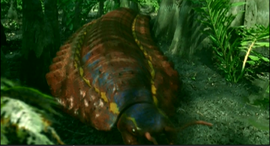| Carboniferous | |||||||||||
|---|---|---|---|---|---|---|---|---|---|---|---|

| |||||||||||
| Previous period Devonian |
Following period Permian | ||||||||||
The Carboniferous time period (the name is derived from the Latin word Carbo that is a form of the Latin word Carbonis - coal) was the fifth time period of the Palaeozoic. It was situated between the Devonian and the Permian, and lasted from 354 to 290 MYA - roughly for 60 million years, give or take 10 million years at each end.
During this time, much of the world was covered in vast swamp forests a nothing was as it seemed. The 50 meter giants towering above the water world may look like trees, but they were actually distant relatives of ferns. Even the air was alien. Over a third is oxygen. Much higher than at any other time in history. This oxygen rich atmosphere had fueled the growth of new, super–sized arthropod predators.
The Carboniferous time period is characterized by shallow inland seas containing both fresh and salt water, as featured in the fifth episode of Prehistoric Park. It is also marked by the noted fluctuations of the sea levels in the Tyan-Shan and Ural mountains, Kazakhstan, western Europe, North America. The climate of the Carboniferous time period was largely moist and warm, but the time period ended in one of the first Ice Ages in the history of the planet, causing a mass extinction.
The sea life of Carboniferous is characterized by foraminferas, corals, echinoderms and mollusks (especially the first ammonites). The belemnites - the ancestors of the modern squids - also appeared at the time. Fishes, however, dominated the seas, and several classes of marine invertebrates (like the trilobites) died-out.
On land, true forests began appear, initially composed of spore-bearing plants and angiosperms. Later, glossopterids began to dominate, especially on the territory of Gondwana. During the Carboniferous time period, there are signs of clear geographical partitioning, centered around the equator, with northern (North Asia) and Southern (Gondwana) tropic belts. The swamps and the coastal shallows accumulated vegetation debris that eventually would become coal (hence the name of the time period).
The land fauna developed among several lines. Giant invertebrates dominated the land, alongside equally big amphibians, and the first reptiles appeared by the middle Carboniferous.
290 MYA the Carboniferous time period ended and the Permian time period began.
Behind the scenes
Impossible Pictures has featured the Carboniferous time period in the second episode of Walking with Monsters. They pictured it as a giant swamp, inhabited by giant spiders (Mesothelae), centipedes (Arthropleura), insects (Meganeura) and amphibians (Proterogyrinus). By contrast the first reptiles (Petrolocosaurus) were small and often preyed-upon by its bigger neighbors, but their new adaptations, such as water-proof scaly skin and more efficient hearts enabled them to outlast their competition and survive the Ice Age at the end of the Carboniferous, eventually evolving into such giants as Edaphosaurus and Dimetrodon.
The Carboniferous was also the setting of the fifth episode of Prehistoric Park, when Nigel Marvin and his team set out to capture a Meganeura, an Arthopleura, and a Pulmonoscorpius - a prehistoric land scorpion. They also encountered a giant amphibian - Crassigyrinus - but they opted to release it back into the wild instead.
Creatures
- Ammonite
- Belemnite
- Beetle
- Centipede
- Crassigyrinus
- Dragonfly
- Horseshoe crab
- Jellyfish
- Fish
- Fly
- Petrolacosaurus
- Proterogyrinus
- Scorpion
- Spider
- Trilobite
